Zoom Beam Expanders: UV Fused Silica

- 0.5X - 2.5X, 1X - 4X, 2X - 8X, or 4X - 16X Continuous Beam Expansion
- Sliding Lens Design Minimizes Beam Walk-Off
- UV Fused Silica Optics for High-Power Applications
- Four AR Coatings Available
ZBE11
0.5X - 2.5X Magnification,
980 - 1130 nm V Coating
Input
Output
ZBE4UVB
4X - 16X Magnification,
240 - 360 nm AR Coating
ZBE22
1X - 4X Magnification,
495 - 570 nm V Coating
Input
Output
Output
Input

Please Wait
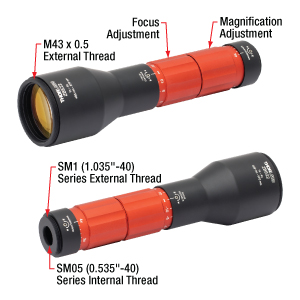
Click for Details
The 1X - 4X and 2X - 8X magnification beam expanders have an externally M43 x 0.5-threaded output. The input is internally SM05-threaded and externally SM1-threaded.
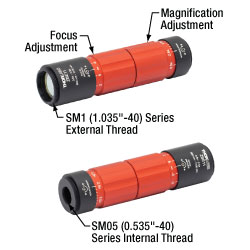
Click for Details
The 0.5X - 2.5X magnification beam expanders have an externally SM1-threaded output. The input is internally SM05-threaded and externally
SM1-threaded.
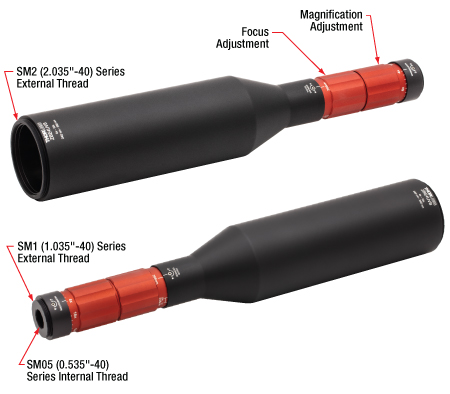
Click for Details
The 4X - 16X magnification beam expanders have an externally SM2-threaded output. The input is internally SM05-threaded and externally SM1-threaded.
Features
- 0.5X - 2.5X, 1X - 4X, 2X - 8X, or 4X - 16X Continuous Beam Expansion
- Collimation Remains Constant During Magnification Change
- Four AR Coating Options Covering Common Laser Lines:
- 240 - 360 nm Broadband
- 330 - 370 nm V Coat
- 495 - 570 nm V Coat
- 980 - 1130 nm V Coat
- Sliding Lenses Minimize Beam Walk-Off
- Housing with Fixed Mechanical Length and Non-Rotating Ends
- Engraved Magnification and Focusing Distance Scales
- Magnification and Collimation Adjustment Rings can be Locked with Included Hex Key
- Threaded Apertures for Easy Integration into Optical Systems
Thorlabs' UV Fused Silica (UVFS) Zoom Beam Expanders can continuously expand or reduce the diameter of a collimated beam over the specified magnification range (0.5X - 2.5X, 1X - 4X, 2X - 8X, or 4X - 16X). These zoom beam expanders use a low-aberration, air-spaced sliding lens design optimized to provide diffraction-limited performance and minimize the impact on the M2 value of the expanded beam. Unlike variable beam expanders, zoom beam expanders do not need to be refocused when the magnification is adjusted since the collimation remains constant.
The sliding lens design allows for the magnification and focusing distance to be adjusted while minimizing the beam walk-off effect that is inherent to lens adjustments. The red rings, shown in the photos to the right, are used to adjust the magnification and focus distance of the output beam; once the desired beam size and collimation is obtained, the rings can be locked by tightening the locking screws using the included 0.050" hex key.
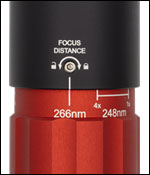
Click for Details
The ZBExUVB Zoom Beam Expanders are engraved with markings indicating the adjustment needed to achieve collimated output.
For a collimated input beam, the output beam remains collimated when the magnification is changed using the adjustment ring, marked by engravings denoting the expansion ratio. An expanded beam can be focused or adjusted to a divergent beam using the focusing distance adjustment ring. The closest focusing distance for the 0.5X - 2.5X expanders is ±0.7 m, for the 1X - 4X and 2X - 8X expanders is ±2 m, and for the 4X - 16X expanders is ±7 m. For the ZBExUVB zoom beam expanders, the closest focusing distances are valid for 266 nm, and the collimation remains constant during changes to the magnification at this wavelength. For all other wavelengths within the coating range (240 nm - 360 nm), the focus adjustment ring needs to be used to re-collimate the beam for the different magnifications and, consequently, the focusing range is limited. The scales of the focus adjustment rings for ZBEx1, ZBEx2, and ZBEx3 beam expanders are engraved with increments from the closest positive and negative focusing distances to infinity, measured from the mounting plane of the front thread of the housing. For ZBExUVB beam expanders, the focus adjustment ring is engraved with markings indicating the adjustment needed to achieve collimated output over the expander's magnification range at specific wavelengths (see image to the left).
The optics used in each beam expander have one of four AR coatings to minimize reflections at the air-to-glass interfaces. Beam expanders with Item #s ending in UVB feature a broadband AR coating designed for 240 - 360 nm. The other beam expanders use optics with one of three V-coatings, named for the shape of the reflectance curve, which reaches an Ravg < 0.2% per surface over the design wavelength range and slopes steeply upwards on either side. This coating design provides a lower reflectance over a narrower operating range when compared to a broadband AR coating. The V-coatings for these Zoom Beam Expanders are centered around one of three wavelengths chosen to match Nd:YAG laser lines: 355 nm, 532 nm, or 1064 nm. See the Specs and AR Coatings tabs for more information on the coating performance.
Mounting Options
All of these Zoom Beam Expanders have a smooth mounting surface with the same 1.2" outer diameter as our Ø1" lens tubes, providing compatibility with post mounting accessories such as the SM1RC(/M) Ø1" Lens Tube Slip Ring and SM1TC Ø1" Lens Tube Clamp and 30 mm cage system mounting accessories such as the CP36 Cage Plate. For the ZBE4x beam expanders, we recommend mounting using the larger Ø2.20" section of the housing; as this is the same diameter as our Ø2" lens tubes, these beam expanders can be post mounted using the SM2RC(/M) Ø2" Lens Tube Slip Ring or SM2TC Ø2" Lens Tube Clamp or integrated directly with a 60 mm cage system using the LCP36 Cage Plate.
Other optomechanical and optical components, such as lens tubes, additional lenses, and filters, can be installed along the optical axis of each beam expander using the threads at the input and output. The inputs of all of the beam expanders feature external SM1 threads and internal SM05 threads. The outputs of the ZB1Ex beam expanders are also externally SM1 threaded. The ZBE2x and ZBE3x beam expanders have M43 x 0.5 threads at the output, but these can be converted to external SM2 threads using the SM2A30 Thread Adapter. Each ZBE4x beam expander output has external SM2 threads.
All housings are designed so that the mounting surfaces and threaded ends do not rotate when turning either the Magnification or the Focusing Distance adjustment ring, allowing the user to adjust the magnification and the divergence without disturbing any attached optics and maintain pointing stability.
Additional Beam Expanders
Thorlabs also offers achromatic zoom beam expanders for broadband applications. Other beam expander options available are our UV fused silica, achromatic, and ZnSe fixed beam expanders, and our reflective beam expanders. For more information on our extensive line of beam expanders, please see the Beam Expanders tab.
| Item # Prefix | ZBE1 | ZBE2 | ZBE3 | ZBE4 |
|---|---|---|---|---|
| Expansion | 0.5X - 2.5X | 1X - 4X | 2X - 8X | 4X - 16X |
| Max Input Beam Diametera | 10.9 mm @ 0.5X 8.0 mm @ 2.5X |
10.9 mm @ 1X 8.8 mm @ 4X |
6.0 mm @ 2X 4.4 mm @ 8X |
6.0 mm @ 4X 2.7 mm @ 16X |
| Diffraction-Limited Input Beam Diametera,b | 10.0 mm @ 0.5X 7.0 mm @ 2.5X |
10.0 mm @ 1X 7.0 mm @ 4X |
5.5 mm @ 2X 3.4 mm @ 8X |
5.5 mm @ 4X 2.5 mm @ 16X |
| Closest Focusing Distancec | ±0.7 m | ±2 m | ±7 m | |
| Pointing Stabilityd | <1 mrad | |||
| Input Thread | Internal: SM05 (0.535"-40) External: SM1 (1.035"-40) |
|||
| Output Thread | External SM1 (1.035"-40) | External M43 x 0.5e | External SM2 (2.035"-40) | |
| Surface Quality | 10-5 Scratch-Dig | |||
| Housing Dimensions | ||||
| Input Housing Diameter | 30.5 mm (1.20")f | |||
| Output Housing Diameter | 30.5 mm (1.20")f | 45.0 mm (1.77") | 55.9 mm (2.20")g | |
| Housing Length | 119.9 mm (4.72") | 170.8 mm (6.72") | 303.2 mm (11.94") | |
| Mounting Optionsh | SM1RC(/M), SM1TC, CP36, SM2A21 | SM1RC(/M), SM1TC, CP36i, SM2A21, SM2A30 | SM1RC(/M)j, SM1TCj, CP36i,j, SM2RC(/M), SM2TCj, LCP36, SM2A21 | |
| AR Coating Specifications | ||||
|---|---|---|---|---|
| Item # Suffix | UVB | 3 | 2 | 1 |
| AR Coating Type | 240 - 360 nm Broadband | 355 nm V-Coat | 532 nm V-Coat | 1064 nm V-Coat |
| Average Reflectancea | - | <0.2% (330 - 370 nm) | <0.2% (495 - 570 nm) | <0.2% (980 - 1130 nm) |
| Max Reflectancea | <1.5% (240 - 360 nm) | <0.7% (325 - 380 nm) <0.2% (335 - 362 nm) |
<0.7% (488 - 580 nm) <0.2% (503 - 553 nm) |
<0.7% (960 - 1160 nm) <0.2% (1000 - 1100 nm) |
| Typical Transmissionb | >89% @ 248 nm >92% @ 266 nm >90% @ 355 nm |
>95% @ 355 nm | >96% @ 532 nm | >96% @ 1064 nm |
| Damage Thresholdc | 5.0 J/cm² (355 nm, 10 ns Pulse, 20 Hz, Ø0.342 mm) |
10.0 J/cm² (355 nm, 10 ns Pulse, 10 Hz, Ø0.406 mm) |
15.0 J/cm² (532 nm, 10 ns Pulse, 20 Hz, Ø0.213 mm) |
20.0 J/cm² (1064 nm, 10 ns Pulse, 20 Hz, Ø0.395 mm) |
The lenses in the UV fused silica zoom beam expanders have one of four AR coatings deposited on both sides of each optic in the beam expanders to minimize reflections at the air-to-glass interfaces. The graphs below show the reflectance per surface as a function of wavelength over an extended wavelength range. Each blue shaded region indicates the specified operating range of the coating; performance outside of this region is not guaranteed.
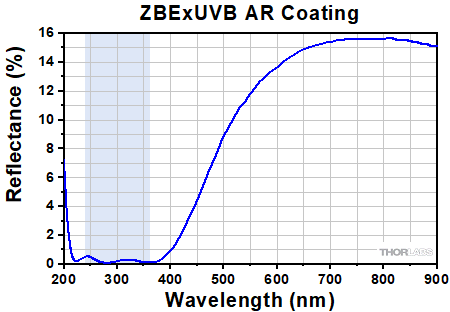
Click to Enlarge
Click Here for Raw Data
The reflectance per surface of the AR coating applied to the optics used in the ZBExUVB UVFS zoom beam expanders. The blue shaded region indicates the 240 - 360 nm operating range where Rmax < 1.5% per surface. Performance outside of this region is provided for reference only and is not guaranteed.
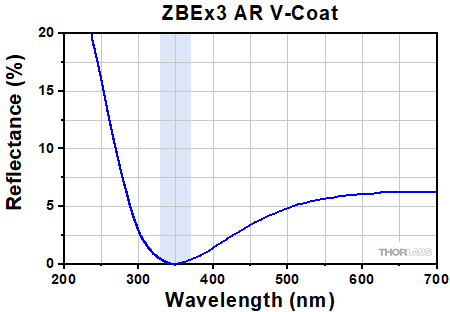
Click to Enlarge
Click Here for Raw Data
The reflectance per surface of the AR coating applied to the optics used in the ZBEx3 UVFS zoom beam expanders. The blue shaded region indicates the 330 - 370 nm operating range where Ravg < 0.2% per surface. Performance outside of this region is provided for reference only and is not guaranteed.
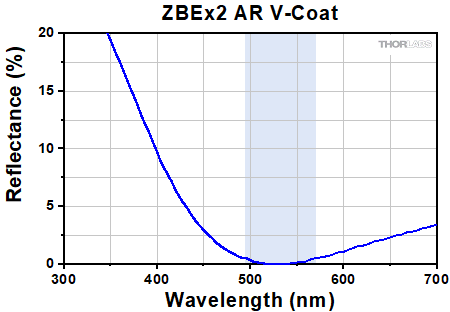
Click to Enlarge
Click Here for Raw Data
The reflectance per surface of the AR coating applied to the optics used in the ZBEx2 UVFS zoom beam expanders. The blue shaded region indicates the 495 - 570 nm operating range where Ravg < 0.2% per surface. Performance outside of this region is provided for reference only and is not guaranteed.
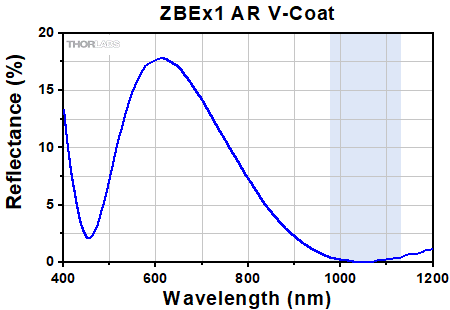
Click to Enlarge
Click Here for Raw Data
The reflectance per surface of the AR coating applied to the optics used in the ZBEx1 UVFS zoom beam expanders. The blue shaded region indicates the 980 - 1130 nm operating range where Ravg < 0.2% per surface. Performance outside of this region is provided for reference only and is not guaranteed.
The interference fringes produced by the SI100 Shearing Interferometer (with a mounted SIVS Viewing Screen) remain parallel to the reference line as the size of the beam changes by adjusting the magnification of the zoom beam expander (Item # ZBE22). For more information on how a shearing interferometer works, please see our full presentation here.
Collimation
Thorlabs' Shearing Interferometers can be used to determine if a coherent beam of light is collimated. The design consists of a wedged optical flat mounted at 45° and a diffuser plate with a ruled reference line down the middle. These interferometers are designed to provide qualitative analysis of a beam's collimation.
The diffuser plate is used to view the interference fringes created by Fresnel reflections from the front and back surfaces of the optical flat. If the beam is collimated, the resulting fringe pattern will be parallel to the ruled reference line. In addition to the degree of collimation, the fringes will also be sensitive to spherical aberration, coma, and astigmatism.
The video to the right shows the output of a shearing interferometer (Item # SI100) with the Magnified View Screen System (Item # SIVS) as the magnification is adjusted on a Zoom Beam Expander (Item # ZBE22). The fringes remain parallel to the reference line, meaning that the beam remains collimated as the size of the beam is adjusted (see images below for a reference).
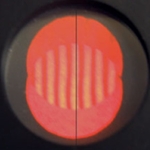
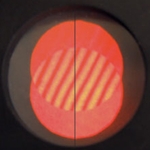
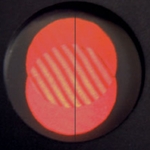
Pointing Stability
The lenses in these Zoom Beam Expanders slide within the housings rather than rotating, which results in superior pointing stability of <1 mrad during magnification adjustments.

Click for Details
The ZBExUVB Zoom Beam Expanders are engraved with markings indicating the adjustment needed to achieve collimated output.
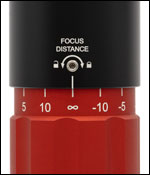
Click for Details
The ZBEx1, ZBEx2, and ZBEx3 Zoom Beam Expanders are engraved with markings indicating the adjustment focus distance in meters.
Adjustment
Thorlabs' Zoom Beam Expanders provide variable magnification between 0.5X - 2.5X (ZBE1x), 1X - 4X (ZBE2x), 2X - 8X (ZBE3x), or 4X - 16X (ZBE4x) while maintaining the collimation of the output beam. In addition, the divergence of the collimated beam can be finely adjusted, or the beam can be focused between ±0.7 m (ZBE1x), ±2 m (ZBE2x and ZBE3x), or ±7 m (ZBE4x) measured from the mounting plane of the front thread of the housing.
The image closest to the right illustrates the two ways to adjust the zoom beam expander. To adjust the focusing distance, rotate the red section of the housing farthest from the input side. This will effectively alter the focus of the beam. To adjust the magnification, rotate the red section closest to the input side. This will effectively alter the size of the beam. The focusing rings for ZBEx1, ZBEx2, and ZBEx3 beam expanders have tick marks engraved to denote the focus distance in meters, while the focusing rings for ZBExUVB beam expanders are engraved with marks to indicate combinations of focus ring and magnification settings that will produce collimated output at specific wavelengths (see the image to the far right). The zoom rings for all beam expanders offered below are engraved with a scale for the magnification.
Each adjustment ring can be locked in place by tightening a setscrew with the included 0.05" hex key.
Imaging and Projection Applications
Thorlabs’ Zoom Beam Expanders are also excellent for any imaging or projection application where a small field of view needs to be enlarged with minimal aberration. The video to the right shows light from an M530L4 530 nm LED light source collimated using an ACL2520U-A molded asphere passing through an R1DS1N USAF target. This is imaged into infinity by an AC254-100-A 100 mm achromat before entering the ZBE12 Zoom Beam Expander. The Zoom Beam Expander images the USAF target onto an EDU-VS1 screen that is placed ~1 m from its output. The video shows the magnification being varied through the entire range (0.5X to 2.5X) and back. The focus plane remains constant, always producing a sharp image of the USAF target, throughout this adjustment. A schematic of the full setup is shown below.
Please note that the ratio of the output to the input angle for an off-axis ray will be equal to the inverted engraved magnification. Therefore, the ratio will be larger at the magnification of 0.5X and smaller at the engraved magnification of 2.5X.
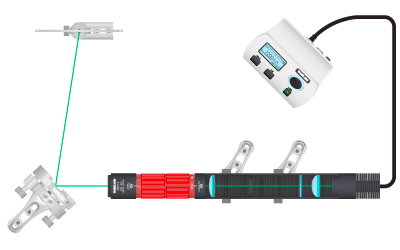
Click for Details USAF target projected on an EDU-VS1 Screen Using a ZBE12 Zoom Beam Expander
| Damage Threshold Specifications | |
|---|---|
| Item # Suffix | Damage Threshold |
| UVB | 5.0 J/cm2 (355 nm, 10 ns Pulse, 20 Hz, Ø0.342 mm) |
| 3 | 10.0 J/cm2 (355 nm, 10 ns Pulse, 10 Hz, Ø0.406 mm) |
| 2 | 15.0 J/cm2 (532 nm, 10 ns Pulse, 20 Hz, Ø0.213 mm) |
| 1 | 20.0 J/cm2 (1064 nm, 10 ns Pulse, 20 Hz, Ø0.395 mm) |
Damage Threshold Data for Thorlabs' Zoom Beam Expanders
The specifications to the right are the damage thresholds for Thorlabs' zoom beam expanders.
nbsp;
Laser Induced Damage Threshold Tutorial
The following is a general overview of how laser induced damage thresholds are measured and how the values may be utilized in determining the appropriateness of an optic for a given application. When choosing optics, it is important to understand the Laser Induced Damage Threshold (LIDT) of the optics being used. The LIDT for an optic greatly depends on the type of laser you are using. Continuous wave (CW) lasers typically cause damage from thermal effects (absorption either in the coating or in the substrate). Pulsed lasers, on the other hand, often strip electrons from the lattice structure of an optic before causing thermal damage. Note that the guideline presented here assumes room temperature operation and optics in new condition (i.e., within scratch-dig spec, surface free of contamination, etc.). Because dust or other particles on the surface of an optic can cause damage at lower thresholds, we recommend keeping surfaces clean and free of debris. For more information on cleaning optics, please see our Optics Cleaning tutorial.
Testing Method
Thorlabs' LIDT testing is done in compliance with ISO/DIS 11254 and ISO 21254 specifications.
First, a low-power/energy beam is directed to the optic under test. The optic is exposed in 10 locations to this laser beam for 30 seconds (CW) or for a number of pulses (pulse repetition frequency specified). After exposure, the optic is examined by a microscope (~100X magnification) for any visible damage. The number of locations that are damaged at a particular power/energy level is recorded. Next, the power/energy is either increased or decreased and the optic is exposed at 10 new locations. This process is repeated until damage is observed. The damage threshold is then assigned to be the highest power/energy that the optic can withstand without causing damage. A histogram such as that below represents the testing of one BB1-E02 mirror.

The photograph above is a protected aluminum-coated mirror after LIDT testing. In this particular test, it handled 0.43 J/cm2 (1064 nm, 10 ns pulse, 10 Hz, Ø1.000 mm) before damage.

| Example Test Data | |||
|---|---|---|---|
| Fluence | # of Tested Locations | Locations with Damage | Locations Without Damage |
| 1.50 J/cm2 | 10 | 0 | 10 |
| 1.75 J/cm2 | 10 | 0 | 10 |
| 2.00 J/cm2 | 10 | 0 | 10 |
| 2.25 J/cm2 | 10 | 1 | 9 |
| 3.00 J/cm2 | 10 | 1 | 9 |
| 5.00 J/cm2 | 10 | 9 | 1 |
According to the test, the damage threshold of the mirror was 2.00 J/cm2 (532 nm, 10 ns pulse, 10 Hz, Ø0.803 mm). Please keep in mind that these tests are performed on clean optics, as dirt and contamination can significantly lower the damage threshold of a component. While the test results are only representative of one coating run, Thorlabs specifies damage threshold values that account for coating variances.
Continuous Wave and Long-Pulse Lasers
When an optic is damaged by a continuous wave (CW) laser, it is usually due to the melting of the surface as a result of absorbing the laser's energy or damage to the optical coating (antireflection) [1]. Pulsed lasers with pulse lengths longer than 1 µs can be treated as CW lasers for LIDT discussions.
When pulse lengths are between 1 ns and 1 µs, laser-induced damage can occur either because of absorption or a dielectric breakdown (therefore, a user must check both CW and pulsed LIDT). Absorption is either due to an intrinsic property of the optic or due to surface irregularities; thus LIDT values are only valid for optics meeting or exceeding the surface quality specifications given by a manufacturer. While many optics can handle high power CW lasers, cemented (e.g., achromatic doublets) or highly absorptive (e.g., ND filters) optics tend to have lower CW damage thresholds. These lower thresholds are due to absorption or scattering in the cement or metal coating.

LIDT in linear power density vs. pulse length and spot size. For long pulses to CW, linear power density becomes a constant with spot size. This graph was obtained from [1].

Pulsed lasers with high pulse repetition frequencies (PRF) may behave similarly to CW beams. Unfortunately, this is highly dependent on factors such as absorption and thermal diffusivity, so there is no reliable method for determining when a high PRF laser will damage an optic due to thermal effects. For beams with a high PRF both the average and peak powers must be compared to the equivalent CW power. Additionally, for highly transparent materials, there is little to no drop in the LIDT with increasing PRF.
In order to use the specified CW damage threshold of an optic, it is necessary to know the following:
- Wavelength of your laser
- Beam diameter of your beam (1/e2)
- Approximate intensity profile of your beam (e.g., Gaussian)
- Linear power density of your beam (total power divided by 1/e2 beam diameter)
Thorlabs expresses LIDT for CW lasers as a linear power density measured in W/cm. In this regime, the LIDT given as a linear power density can be applied to any beam diameter; one does not need to compute an adjusted LIDT to adjust for changes in spot size, as demonstrated by the graph to the right. Average linear power density can be calculated using the equation below.

The calculation above assumes a uniform beam intensity profile. You must now consider hotspots in the beam or other non-uniform intensity profiles and roughly calculate a maximum power density. For reference, a Gaussian beam typically has a maximum power density that is twice that of the uniform beam (see lower right).
Now compare the maximum power density to that which is specified as the LIDT for the optic. If the optic was tested at a wavelength other than your operating wavelength, the damage threshold must be scaled appropriately. A good rule of thumb is that the damage threshold has a linear relationship with wavelength such that as you move to shorter wavelengths, the damage threshold decreases (i.e., a LIDT of 10 W/cm at 1310 nm scales to 5 W/cm at 655 nm):

While this rule of thumb provides a general trend, it is not a quantitative analysis of LIDT vs wavelength. In CW applications, for instance, damage scales more strongly with absorption in the coating and substrate, which does not necessarily scale well with wavelength. While the above procedure provides a good rule of thumb for LIDT values, please contact Tech Support if your wavelength is different from the specified LIDT wavelength. If your power density is less than the adjusted LIDT of the optic, then the optic should work for your application.
Please note that we have a buffer built in between the specified damage thresholds online and the tests which we have done, which accommodates variation between batches. Upon request, we can provide individual test information and a testing certificate. The damage analysis will be carried out on a similar optic (customer's optic will not be damaged). Testing may result in additional costs or lead times. Contact Tech Support for more information.
Pulsed Lasers
As previously stated, pulsed lasers typically induce a different type of damage to the optic than CW lasers. Pulsed lasers often do not heat the optic enough to damage it; instead, pulsed lasers produce strong electric fields capable of inducing dielectric breakdown in the material. Unfortunately, it can be very difficult to compare the LIDT specification of an optic to your laser. There are multiple regimes in which a pulsed laser can damage an optic and this is based on the laser's pulse length. The highlighted columns in the table below outline the relevant pulse lengths for our specified LIDT values.
Pulses shorter than 10-9 s cannot be compared to our specified LIDT values with much reliability. In this ultra-short-pulse regime various mechanics, such as multiphoton-avalanche ionization, take over as the predominate damage mechanism [2]. In contrast, pulses between 10-7 s and 10-4 s may cause damage to an optic either because of dielectric breakdown or thermal effects. This means that both CW and pulsed damage thresholds must be compared to the laser beam to determine whether the optic is suitable for your application.
| Pulse Duration | t < 10-9 s | 10-9 < t < 10-7 s | 10-7 < t < 10-4 s | t > 10-4 s |
|---|---|---|---|---|
| Damage Mechanism | Avalanche Ionization | Dielectric Breakdown | Dielectric Breakdown or Thermal | Thermal |
| Relevant Damage Specification | No Comparison (See Above) | Pulsed | Pulsed and CW | CW |
When comparing an LIDT specified for a pulsed laser to your laser, it is essential to know the following:

LIDT in energy density vs. pulse length and spot size. For short pulses, energy density becomes a constant with spot size. This graph was obtained from [1].
- Wavelength of your laser
- Energy density of your beam (total energy divided by 1/e2 area)
- Pulse length of your laser
- Pulse repetition frequency (prf) of your laser
- Beam diameter of your laser (1/e2 )
- Approximate intensity profile of your beam (e.g., Gaussian)
The energy density of your beam should be calculated in terms of J/cm2. The graph to the right shows why expressing the LIDT as an energy density provides the best metric for short pulse sources. In this regime, the LIDT given as an energy density can be applied to any beam diameter; one does not need to compute an adjusted LIDT to adjust for changes in spot size. This calculation assumes a uniform beam intensity profile. You must now adjust this energy density to account for hotspots or other nonuniform intensity profiles and roughly calculate a maximum energy density. For reference a Gaussian beam typically has a maximum energy density that is twice that of the 1/e2 beam.
Now compare the maximum energy density to that which is specified as the LIDT for the optic. If the optic was tested at a wavelength other than your operating wavelength, the damage threshold must be scaled appropriately [3]. A good rule of thumb is that the damage threshold has an inverse square root relationship with wavelength such that as you move to shorter wavelengths, the damage threshold decreases (i.e., a LIDT of 1 J/cm2 at 1064 nm scales to 0.7 J/cm2 at 532 nm):

You now have a wavelength-adjusted energy density, which you will use in the following step.
Beam diameter is also important to know when comparing damage thresholds. While the LIDT, when expressed in units of J/cm², scales independently of spot size; large beam sizes are more likely to illuminate a larger number of defects which can lead to greater variances in the LIDT [4]. For data presented here, a <1 mm beam size was used to measure the LIDT. For beams sizes greater than 5 mm, the LIDT (J/cm2) will not scale independently of beam diameter due to the larger size beam exposing more defects.
The pulse length must now be compensated for. The longer the pulse duration, the more energy the optic can handle. For pulse widths between 1 - 100 ns, an approximation is as follows:

Use this formula to calculate the Adjusted LIDT for an optic based on your pulse length. If your maximum energy density is less than this adjusted LIDT maximum energy density, then the optic should be suitable for your application. Keep in mind that this calculation is only used for pulses between 10-9 s and 10-7 s. For pulses between 10-7 s and 10-4 s, the CW LIDT must also be checked before deeming the optic appropriate for your application.
Please note that we have a buffer built in between the specified damage thresholds online and the tests which we have done, which accommodates variation between batches. Upon request, we can provide individual test information and a testing certificate. Contact Tech Support for more information.
[1] R. M. Wood, Optics and Laser Tech. 29, 517 (1998).
[2] Roger M. Wood, Laser-Induced Damage of Optical Materials (Institute of Physics Publishing, Philadelphia, PA, 2003).
[3] C. W. Carr et al., Phys. Rev. Lett. 91, 127402 (2003).
[4] N. Bloembergen, Appl. Opt. 12, 661 (1973).
In order to illustrate the process of determining whether a given laser system will damage an optic, a number of example calculations of laser induced damage threshold are given below. For assistance with performing similar calculations, we provide a spreadsheet calculator that can be downloaded by clicking the button to the right. To use the calculator, enter the specified LIDT value of the optic under consideration and the relevant parameters of your laser system in the green boxes. The spreadsheet will then calculate a linear power density for CW and pulsed systems, as well as an energy density value for pulsed systems. These values are used to calculate adjusted, scaled LIDT values for the optics based on accepted scaling laws. This calculator assumes a Gaussian beam profile, so a correction factor must be introduced for other beam shapes (uniform, etc.). The LIDT scaling laws are determined from empirical relationships; their accuracy is not guaranteed. Remember that absorption by optics or coatings can significantly reduce LIDT in some spectral regions. These LIDT values are not valid for ultrashort pulses less than one nanosecond in duration.

A Gaussian beam profile has about twice the maximum intensity of a uniform beam profile.
CW Laser Example
Suppose that a CW laser system at 1319 nm produces a 0.5 W Gaussian beam that has a 1/e2 diameter of 10 mm. A naive calculation of the average linear power density of this beam would yield a value of 0.5 W/cm, given by the total power divided by the beam diameter:

However, the maximum power density of a Gaussian beam is about twice the maximum power density of a uniform beam, as shown in the graph to the right. Therefore, a more accurate determination of the maximum linear power density of the system is 1 W/cm.
An AC127-030-C achromatic doublet lens has a specified CW LIDT of 350 W/cm, as tested at 1550 nm. CW damage threshold values typically scale directly with the wavelength of the laser source, so this yields an adjusted LIDT value:

The adjusted LIDT value of 350 W/cm x (1319 nm / 1550 nm) = 298 W/cm is significantly higher than the calculated maximum linear power density of the laser system, so it would be safe to use this doublet lens for this application.
Pulsed Nanosecond Laser Example: Scaling for Different Pulse Durations
Suppose that a pulsed Nd:YAG laser system is frequency tripled to produce a 10 Hz output, consisting of 2 ns output pulses at 355 nm, each with 1 J of energy, in a Gaussian beam with a 1.9 cm beam diameter (1/e2). The average energy density of each pulse is found by dividing the pulse energy by the beam area:

As described above, the maximum energy density of a Gaussian beam is about twice the average energy density. So, the maximum energy density of this beam is ~0.7 J/cm2.
The energy density of the beam can be compared to the LIDT values of 1 J/cm2 and 3.5 J/cm2 for a BB1-E01 broadband dielectric mirror and an NB1-K08 Nd:YAG laser line mirror, respectively. Both of these LIDT values, while measured at 355 nm, were determined with a 10 ns pulsed laser at 10 Hz. Therefore, an adjustment must be applied for the shorter pulse duration of the system under consideration. As described on the previous tab, LIDT values in the nanosecond pulse regime scale with the square root of the laser pulse duration:

This adjustment factor results in LIDT values of 0.45 J/cm2 for the BB1-E01 broadband mirror and 1.6 J/cm2 for the Nd:YAG laser line mirror, which are to be compared with the 0.7 J/cm2 maximum energy density of the beam. While the broadband mirror would likely be damaged by the laser, the more specialized laser line mirror is appropriate for use with this system.
Pulsed Nanosecond Laser Example: Scaling for Different Wavelengths
Suppose that a pulsed laser system emits 10 ns pulses at 2.5 Hz, each with 100 mJ of energy at 1064 nm in a 16 mm diameter beam (1/e2) that must be attenuated with a neutral density filter. For a Gaussian output, these specifications result in a maximum energy density of 0.1 J/cm2. The damage threshold of an NDUV10A Ø25 mm, OD 1.0, reflective neutral density filter is 0.05 J/cm2 for 10 ns pulses at 355 nm, while the damage threshold of the similar NE10A absorptive filter is 10 J/cm2 for 10 ns pulses at 532 nm. As described on the previous tab, the LIDT value of an optic scales with the square root of the wavelength in the nanosecond pulse regime:

This scaling gives adjusted LIDT values of 0.08 J/cm2 for the reflective filter and 14 J/cm2 for the absorptive filter. In this case, the absorptive filter is the best choice in order to avoid optical damage.
Pulsed Microsecond Laser Example
Consider a laser system that produces 1 µs pulses, each containing 150 µJ of energy at a repetition rate of 50 kHz, resulting in a relatively high duty cycle of 5%. This system falls somewhere between the regimes of CW and pulsed laser induced damage, and could potentially damage an optic by mechanisms associated with either regime. As a result, both CW and pulsed LIDT values must be compared to the properties of the laser system to ensure safe operation.
If this relatively long-pulse laser emits a Gaussian 12.7 mm diameter beam (1/e2) at 980 nm, then the resulting output has a linear power density of 5.9 W/cm and an energy density of 1.2 x 10-4 J/cm2 per pulse. This can be compared to the LIDT values for a WPQ10E-980 polymer zero-order quarter-wave plate, which are 5 W/cm for CW radiation at 810 nm and 5 J/cm2 for a 10 ns pulse at 810 nm. As before, the CW LIDT of the optic scales linearly with the laser wavelength, resulting in an adjusted CW value of 6 W/cm at 980 nm. On the other hand, the pulsed LIDT scales with the square root of the laser wavelength and the square root of the pulse duration, resulting in an adjusted value of 55 J/cm2 for a 1 µs pulse at 980 nm. The pulsed LIDT of the optic is significantly greater than the energy density of the laser pulse, so individual pulses will not damage the wave plate. However, the large average linear power density of the laser system may cause thermal damage to the optic, much like a high-power CW beam.
| Posted Comments: | |
| No Comments Posted |
Thorlabs offers fixed magnification beam expanders, as well as zoom beam expanders that do not need to be refocused when the magnification is adjusted since the collimation remains constant. The table below provides a direct comparison of the options we offer. Please contact Tech Support if you would like help choosing the best beam expander for your specific application.
| Beam Expander Description |
Fixed Magnification UVFS Laser Line, Sliding Lens |
Fixed Magnification Achromatic, Sliding Lens |
Fixed Magnification Mid-Infrared, Sliding Lens |
|---|---|---|---|
| Expansions Available | 2X, 3X, 5X, 10X, 20Xa | 2X, 3X, 5X, 10X, 15X, 20X |
2X, 5X, 10X |
| AR Coating Range(s) (Item # Suffix) |
240 - 360 nm (-UVB) 248 - 287 nm (-266) 325 - 380 nm (-355) 488 - 580 nm (-532) 960 - 1064 nm (-1064) |
400 - 650 nm (-A) 650 - 1050 nm (-B) 1050 - 1650 nm (-C) |
7 - 12 μm (-E3) |
| Mirror Coating (Range) | N/A | ||
| Reflectance (per Surface) | Rmax < 1.5% (-UVB) Ravg < 0.2% (All Others) |
Rmax < 0.5% | Ravg < 1.0% |
| Max Input Beam Diameter | 2X: 8.5 mm 3X: 9.0 mm 5X: 4.3 mm 10X: 2.8 mm 20X: 2.0 mm |
2X: 8.5 mm 3X: 9.0 mm 5X: 5.0 mm 10X: 3.0 mm 15X: 2.5 mm 20X: 2.0 mm |
2X: 9.5 mm 5X: 6.7 mm 10X: 3.5 mm |
| Wavefront Error | <λ/4 (Peak to Valley) | ||
| Surface Quality | 10-5 Scratch-Dig | 20-10 Scratch-Dig | 80-50 Scratch-Dig |
| Beam Expander Description |
Zoom UVFS, Sliding Lens |
Zoom Achromatic, Sliding Lens |
Reflective Beam Expander Fixed Magnification |
|---|---|---|---|
| Expansions Available | 0.5X - 2.5X, 1X - 4X, 2X - 8X, 4X - 16X |
0.5X - 2.5X, 1X - 4X, 2X - 8X, 4X - 16X |
2X, 4X, 6X |
| AR Coating Range(s) (Item # Suffix) |
240 - 360 nm (UVB) 330 - 370 nm (3) 495 - 570 nm (2) 980 - 1130 nm (1) |
400 - 650 nm (A) 650 - 1050 nm (B) 1050 - 1650 nm (C) |
N/A |
| Mirror Coating (Range) | N/A | Protected Silver (450 nm - 20 μm) |
|
| Rmax < 1.5% for (UVB) Ravg < 0.2% (All Others) |
Rmax < 0.5% | Ravg > 95% | |
| Max Input Beam Diameter | 0.5X - 2.5X: 10.9 to 8.0 mm 1X - 4X: 10.9 to 8.8 mm 2X - 8X: 6.0 to 4.4 mm 4X - 16X: 6.0 to 2.7 mm |
0.5X - 2.5X: 10.9 to 8.0 mm 1X - 4X: 10.9 to 8.8 mm 2X - 8X: 6.0 to 4.4 mm 4X - 16X: 6.0 to 2.7 mm |
3 mm |
| Wavefront Error | <λ/4 (Peak to Valley) | <λ/10a (RMS) | |
| Surface Quality | 10-5 Scratch-Dig | 20-10 Scratch-Dig | 40-20 Scratch-Dig |

| Item # | Expansion | Max Input Beam Diameter |
Diffraction-Limited Input Beam Diametera |
Input Thread | Output Thread (External) |
AR Coatingb | Typical Transmission |
Damage Thresholdc |
|---|---|---|---|---|---|---|---|---|
| ZBE1UVB | 0.5X - 2.5X | 10.9 mm @ 0.5X 8.0 mm @ 2.5X |
10.0 mm @ 0.5X 7.0 mm @ 2.5X |
Internal: SM05 External: SM1 |
SM1 | Rmax<1.5% (240 - 360 nm) | >89% @ 248 nm >92% @ 266 nm >90% @ 355 nm |
5.0 J/cm² (355 nm, 10 ns Pulse, 20 Hz, Ø0.342 mm) |
| ZBE2UVB | 1X - 4X | 10.9 mm @ 1X 8.8 mm @ 4X |
10.0 mm @ 1X 7.0 mm @ 4X |
M43 x 0.5d | ||||
| ZBE3UVB | 2X - 8X | 6.0 mm @ 2X 4.4 mm @ 8X |
5.5 mm @ 2X 3.4 mm @ 8X |
|||||
| ZBE4UVB | 4X - 16X | 6.0 mm @ 4X 2.7 mm @ 16X |
5.5 mm @ 4X 2.5 mm @ 16X |
SM2 |

| Item # | Expansion | Max Input Beam Diameter |
Diffraction-Limited Input Beam Diametera |
Input Thread | Output Thread (External) |
AR Coatingb | Typical Transmission |
Damage Thresholdc |
|---|---|---|---|---|---|---|---|---|
| ZBE13 | 0.5X - 2.5X | 10.9 mm @ 0.5X 8.0 mm @ 2.5X |
10.0 mm @ 0.5X 7.0 mm @ 2.5X |
Internal: SM05 External: SM1 |
SM1 | Ravg < 0.2% (330 - 370 nm) Rmax < 0.7% (325 - 380 nm) Rmax < 0.2% (335 - 362 nm) |
>95% @ 355 nm | 10.0 J/cm² (355 nm, 10 ns Pulse, 10 Hz, Ø0.406 mm) |
| ZBE23 | 1X - 4X | 10.9 mm @ 1X 8.8 mm @ 4X |
10.0 mm @ 1X 7.0 mm @ 4X |
M43 x 0.5d | ||||
| ZBE33 | 2X - 8X | 6.0 mm @ 2X 4.4 mm @ 8X |
5.5 mm @ 2X 3.4 mm @ 8X |
|||||
| ZBE43 | 4X - 16X | 6.0 mm @ 4X 2.7 mm @ 16X |
5.5 mm @ 4X 2.5 mm @ 16X |
SM2 |

| Item # | Expansion | Max Input Beam Diameter |
Diffraction-Limited Input Beam Diametera |
Input Thread | Output Thread (External) |
AR Coatingb | Typical Transmission |
Damage Thresholdc |
|---|---|---|---|---|---|---|---|---|
| ZBE12 | 0.5X - 2.5X | 10.9 mm @ 0.5X 8.0 mm @ 2.5X |
10.0 mm @ 0.5X 7.0 mm @ 2.5X |
Internal: SM05 External: SM1 |
SM1 | Ravg < 0.2% (495 - 570 nm) Rmax < 0.7% (488 - 580 nm) Rmax < 0.2% (503 - 553 nm) |
>96% @ 532 nm | 15.0 J/cm² (532 nm, 10 ns Pulse, 20 Hz, Ø0.213 mm) |
| ZBE22 | 1X - 4X | 10.9 mm @ 1X 8.8 mm @ 4X |
10.0 mm @ 1X 7.0 mm @ 4X |
M43 x 0.5d | ||||
| ZBE32 | 2X - 8X | 6.0 mm @ 2X 4.4 mm @ 8X |
5.5 mm @ 2X 3.4 mm @ 8X |
|||||
| ZBE42 | 4X - 16X | 6.0 mm @ 4X 2.7 mm @ 16X |
5.5 mm @ 4X 2.5 mm @ 16X |
SM2 |

| Item # | Expansion | Max Input Beam Diameter |
Diffraction-Limited Input Beam Diametera |
Input Thread | Output Thread (External) |
AR Coatingb | Typical Transmission |
Damage Thresholdc |
|---|---|---|---|---|---|---|---|---|
| ZBE11 | 0.5X - 2.5X | 10.9 mm @ 0.5X 8.0 mm @ 2.5X |
10.0 mm @ 0.5X 7.0 mm @ 2.5X |
Internal: SM05 External: SM1 |
SM1 | Ravg < 0.2% (980 - 1130 nm) Rmax < 0.7% (960 - 1160 nm) Rmax < 0.2% (1000 - 1100 nm) |
>96% @ 1064 nm | 20.0 J/cm² (1064 nm, 10 ns Pulse, 20 Hz, Ø0.395 mm) |
| ZBE21 | 1X - 4X | 10.9 mm @ 1X 8.8 mm @ 4X |
10.0 mm @ 1X 7.0 mm @ 4X |
M43 x 0.5d | ||||
| ZBE31 | 2X - 8X | 6.0 mm @ 2X 4.4 mm @ 8X |
5.5 mm @ 2X 3.4 mm @ 8X |
|||||
| ZBE41 | 4X - 16X | 6.0 mm @ 4X 2.7 mm @ 16X |
5.5 mm @ 4X 2.5 mm @ 16X |
SM2 |

Several mounting options for the Zoom Beam Expanders are provided in the table below. For our complete selection of thread adapters, see our Optical Component Thread Adapters selection guide.
| Item # | SM1RC(/M) | SM2RC(/M) | SM1TC | SM2TC | CP36 | LCP36 | SM2A21 | SM2A30 |
|---|---|---|---|---|---|---|---|---|
| Photo (Click to Enlarge) |
 |
 |
 |
 |
 |
 |
 |
 |
| Application | Slip Ring for Post Mounting | Clamp for Post Mounting | 30 mm Cage Mount for Ø1.2" Housing | 60 mm Cage Mount for Ø2.2" Housing | Mount Beam Expander in Ø2" or SM2-Threaded Optic Mounts |
Integrate Beam Expander with SM2-Threaded Components | ||
| Compatible Achromatic Zoom Beam Expanders (Item # Prefix) | ZBE1 ZBE2 ZBE3 ZBE4a |
ZBE4 | ZBE1 ZBE2 ZBE3 ZBE4a |
ZBE4 | ZBE1 ZBE2b ZBE3b ZBE4a,b |
ZBE4 | ZBE1 ZBE2 ZBE3 ZBE4a |
ZBE2 ZBE3 |
| Internal Bore / Threads |
Ø1.2" Bore | Ø2.2" Bore | Ø1.2" Bore | Ø2.2" Bore | Ø1.2" Bore | Ø2.2" Bore | Ø1.2" Bore | M43 x 0.5 Threads |
| - | - | - | - | - | - | SM2 Threads and Ø2" Smooth Surface |
SM2 Threads | |
| Mounting Holes | 8-32 (M4) Tap | #8 (M4) Counterbore | Compatible with 30 mm Cage Systems |
Compatible with 60 mm Cage Systems |
- | - | ||
 Products Home
Products Home












 Zoom Beam Expanders UVFS
Zoom Beam Expanders UVFS